
Trifle is a layered dessert of English origin. The usual ingredients are a thin layer of sponge fingers or sponge cake soaked in sherry or another fortified wine, a fruit element, custard and whipped cream layered in that ascending order in a glass dish. The contents of a trifle are highly variable and many varieties exist, some forgoing fruit entirely and instead using other ingredients, such as chocolate, coffee or vanilla. The fruit and sponge layers may be suspended in fruit-flavoured jelly, and these ingredients are usually arranged to produce three or four layers. The assembled dessert can be topped with whipped cream or, more traditionally, syllabub.

A crumble is typically a dessert with a crumbly topping consisting of flour, butter, sugar, and sometimes oats, baked over a fruit filling. Apple and rhubarb are two popular varieties. Savoury fillings such as meat, cheese or vegetables may alternatively be used. As a dessert, crumbles are traditionally served with custard, cream, or ice cream.
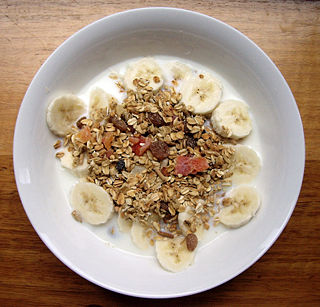
Muesli is a cold Swiss breakfast dish, the primary ingredient of which is rolled oats. Traditionally, it is set to soak overnight and eaten the next morning. Additional ingredients, such as grains, nuts, seeds, and fresh or dried fruits are sometimes added, along with milk or cream, a small amount of citrus juice, and honey to add sweetness. Yoghurt, other milk products, or milk substitutes are now commonly added to both homemade and commercially packaged muesli recipes.
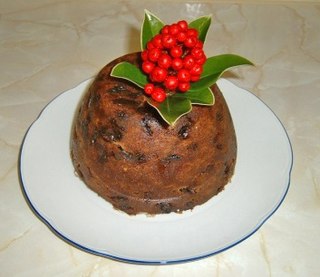
Christmas pudding is sweet, dried-fruit pudding traditionally served as part of Christmas dinner in Britain and other countries to which the tradition has been exported. It has its origins in medieval England, with early recipes making use of dried fruit, suet, breadcrumbs, flour, eggs and spice, along with liquid such as milk or fortified wine. Later, recipes became more elaborate. In 1845, cookery writer Eliza Acton wrote the first recipe for a dish actually called "Christmas pudding".
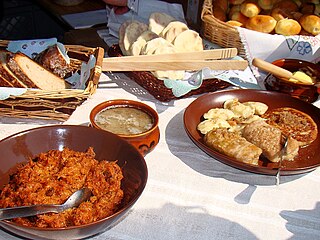
Polish cuisine is a style of food preparation originating in and widely popular in Poland. Due to Poland's history, Polish cuisine has evolved over the centuries to be very eclectic, and shares many similarities with other national cuisines. Polish cooking in other cultures is often referred to as à la polonaise.

Rice pudding is a dish made from rice mixed with water or milk and commonly other ingredients such as sweeteners, spices, flavourings and sometimes eggs.

Coleslaw, also known as cole slaw or simply as slaw, is a side dish consisting primarily of finely shredded raw cabbage with a salad dressing or condiment, commonly either vinaigrette or mayonnaise. This dish originated in the Netherlands in the 18th century. Coleslaw prepared with vinaigrette may benefit from the long lifespan granted by pickling.

Cobbler is a dessert consisting of a fruit filling poured into a large baking dish and covered with a batter, biscuit, or dumpling before being baked. Some cobbler recipes, especially in the American South, resemble a thick-crusted, deep-dish pie with both a top and bottom crust. Cobbler is part of the cuisine of the United Kingdom and United States, and should not be confused with a crumble.
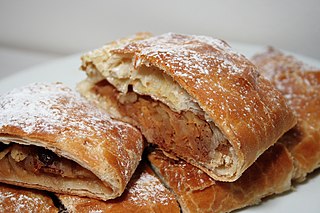
Apple strudel is a traditional Viennese strudel, a popular pastry in Austria, Bavaria, the Czech Republic, Northern Italy, Slovenia, Croatia, and other countries in Europe that once belonged to the Austro-Hungarian Empire (1867–1918).

Apple crisp is a dessert made with a streusel topping. In the US, it is also called apple crumble, a word which refers to a different dessert in the UK, Canada, Australia, and New Zealand.

Carrot cake is cake that contains carrots mixed into the batter.
Hasty pudding is a pudding or porridge of grains cooked in milk or water. In the United States, it often refers specifically to a version made primarily with ground ("Indian") corn, and it is mentioned in the lyrics of "Yankee Doodle", a traditional American song of the 18th century.

A charlotte is a type of bread pudding that can be served hot or cold. It is also referred to as an "icebox cake". Bread, sponge cake, crumbs or biscuits/cookies are used to line a mold, which is then filled with a fruit puree or custard. The baked pudding could then be sprinkled with powdered sugar and glazed with a salamander, a red-hot iron plate attached to a long handle, though modern recipes would likely use more practical tools to achieve a similar effect.
There are many geographically indicated foods of the United Kingdom. In British cuisine, there is a custom of naming foodstuffs with reference to their place of origin. However, there are other reasons for this practice; Scotch egg, which was invented in London and Dover sole which indicates where they were landed, for example.

Better than sex cake is a cake baked using yellow cake mix, with a juicy pineapple center, covered with layers of vanilla pudding and sweetened whipped cream, and sprinkled with coconut flakes. A variant using chocolate cake mix, caramel topping, and crumbled toffee is known by similar names such as better than Robert Redford cake.
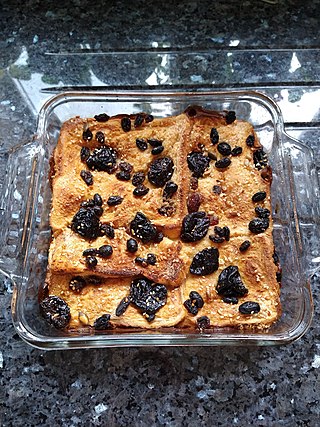
Bread and butter pudding is a traditional bread pudding in British cuisine. Slices of buttered bread scattered with raisins are layered in an oven dish, covered with an egg custard mixture seasoned with nutmeg, vanilla, or other spices, then baked.

Sponge cake is a light cake made with eggs, flour and sugar, sometimes leavened with baking powder. Some sponge cakes do not contain egg yolks, like angel food cake, but most of them do. Sponge cakes, leavened with beaten eggs, originated during the Renaissance, possibly in Spain. The sponge cake is thought to be one of the first non-yeasted cakes, and the earliest attested sponge cake recipe in English is found in a book by the English poet Gervase Markham, The English Huswife, Containing the Inward and Outward Virtues Which Ought to Be in a Complete Woman (1615). Still, the cake was much more like a cracker: thin and crispy. Sponge cakes became the cake recognised today when bakers started using beaten eggs as a rising agent in the mid-18th century. The Victorian creation of baking powder by English food manufacturer Alfred Bird in 1843 allowed the addition of butter to the traditional sponge recipe, resulting in the creation of the Victoria sponge. Cakes are available in many flavours and have many recipes as well. Sponge cakes have become snack cakes via the Twinkie.















